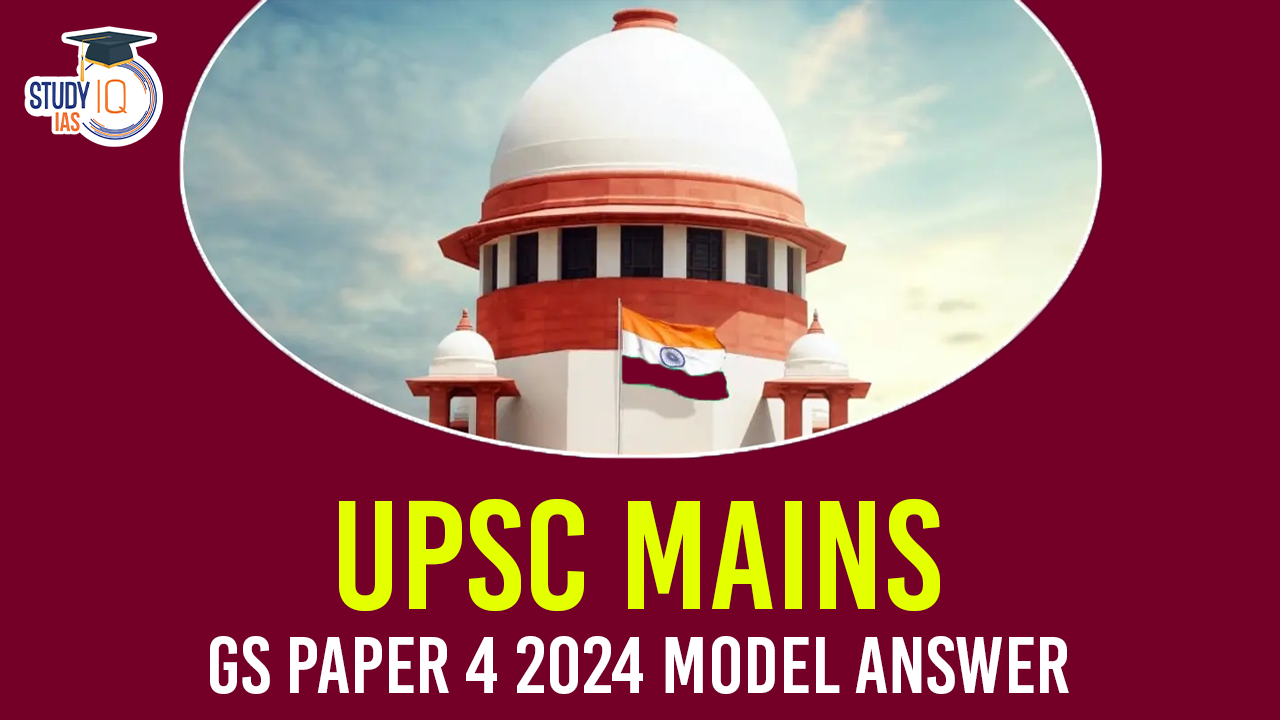Table of Contents
Q9. With a multipronged strategy of the Central and State Governments, especially in the last few years, the naxalite problem has been resolved to a large extent in the affected states of the country. However, there are a few pockets in certain states where the naxalite problem still persists, mainly due to the involvement of foreign countries. Rohit is posted as SP (Special Operations) for the last one year, in one of the districts which is still affected by the naxalite problem. The district administration has taken a lot of developmental works in the recent past in the naxalite-affected areas to win the hearts and minds of the people.
Over a period of time, Rohit has established an excellent intelligence network to get real-time information regarding the movement of naxalite cadre. To instill confidence in the public and have moral ascendancy over the naxalites, a number of cordon and search operations are being conducted by the police. Rohit, who himself was leading one of the contingents, got a message through his intelligence source that about ten hardcore naxalites were hiding in a particular village with sophisticated weapons. Without wasting any time, Rohit reached the target village with his team and laid out a foolproof cordon and started carrying out a systematic search.
During the search, his team managed to overpower all the naxalites along with their automatic weapons. However, in the meantime, more than a hundred tribal women surrounded the village and started marching towards the target house. They were shouting and demanding the immediate release of insurgents since they are their protectors and saviors. The situation on the ground was becoming very critical as the tribal women were extremely agitated and aggressive. Rohit tried to contact his superior officer (IG Special Operations) of the state on the radio set and on mobile phone, but failed to do so due to poor connectivity. Rohit was in great dilemma since out of the naxalites apprehended, two were not only hardcore top insurgents with prize money of ₹10 lakhs on their heads, but were also involved in a recent ambush on the security forces. However, if he did not release the naxalites, the situation could get out of control since the tribal women were aggressively charging towards them. In that case, to control the situation, Rohit might have to resort to firing, which may lead to valuable loss of lives of civilians and would further complicate the situation.
- What are the options available with Rohit to cope with the situation?
- What are the ethical dilemmas being faced by Rohit?
- Which of the options, do you think, would be more appropriate for Rohit to adopt and why?
- In the present situation, what are the extra precautionary measures to be taken by the police in dealing with women protesters? (Answer in 250 words)
Introduction
Naxalism is one of the biggest internal security challenges, not only because it involves violence and law-and-order issues, but also due to the Naxals’ strategy of brainwashing locals and creating a base of sympathisers. This further aggravates challenges for security apparatus.This case study highlights this issue.
|
Stakeholders
|
Options available with Rohit to cope with the situation
Option 1: Release the Naxalites to Avoid Escalation
Merits
- Avoids Immediate Conflict: Releasing the naxalites could prevent violence, protecting the lives of tribal women and the police.
- Maintains Public Order: Immediate de-escalation may prevent further unrest or larger community backlash against the authorities.
Demerits
- Weakening of Law Enforcement: It undermines the legal authority of the police, signalling that insurgents can pressure the state through mob tactics.
- Empowering Naxalites: The release of hardcore naxalites could strengthen their movement and demoralise security forces.
- Loss of Operational Gains: Allowing top insurgents to escape erodes the hard-won success of the intelligence and search operation.
Option 2: Use of Force to Control the Crowd
Merits
- Immediate Control Over the Situation: The use of force could restore order and allow the police to complete their mission without releasing insurgents.
- Asserting State Authority: Demonstrates the resolve of the state to uphold law and order, regardless of mob pressure.
Demerits
- Civilian Casualties: The use of force could lead to the loss of lives among the protesting tribal women, which would cause outrage and damage public trust.
- Further Alienation of Locals: Violence against civilians would deepen resentment among the local tribal population and may fuel the insurgency.
- Human Rights Violations: Use of lethal force on unarmed women could result in legal and ethical violations, tarnishing the police’s reputation.
Option 3: Negotiate with the Tribal Women
Merits
- Non-violent De-escalation: Rohit can attempt to calm the tribal women by engaging in dialogue. He can emphasize the developmental work being done by the government and the need for peace.
- Maintains Public Trust: A peaceful resolution would help maintain trust between the tribal community and the authorities, fostering long-term cooperation.
Demerits
- Time-sensitive: Negotiations may take time, and the situation could escalate before a resolution is reached.
- Uncertain Outcome: There is no guarantee that the tribal women will agree to a peaceful resolution without demanding concessions.
Option 4: Stand Ground and Wait for Further Instructions
Merits:
- Buys Time for Better Planning: By holding the position, Rohit may be able to contact his superiors and gain clearer instructions on how to proceed.
- Avoids Immediate Confrontation: This approach may calm the situation, as it avoids taking any immediate action that could provoke the protesters.
Demerits:
- Situation May Worsen: The crowd could grow larger and more aggressive if no action is taken, leading to greater difficulty in handling the situation later.
- Risk of Losing Control: Without active intervention, Rohit may lose control of the situation, which could result in a forced confrontation later.
Ethical Dilemmas Faced by Rohit:
- Rule of law and maintaining peace: Rohit faces a conflict between ensuring the immediate safety of civilians and maintaining law and order by arresting insurgents.
- Use of Force vs Persuasion: Using force could save his team and enforce the law, but it may result in civilian deaths, potentially undermining the moral legitimacy of the police.
- Professional Duty vs. Public Trust: Rohit’s duty to capture and prosecute criminals conflicts with the potential alienation of the tribal community, which could lead to long-term distrust of law enforcement.
- Short-term Gain vs. Long-term Consequences: Releasing the naxalites could temporarily resolve the situation but may empower insurgents and weaken state authority.
Appropriate Course of Action:
- The most appropriate course of action would be negotiation and communication combined with a strategic withdrawal if needed.
- Rohit could engage with the tribal women, explaining that the apprehended naxalites are criminals responsible for violence and offer assurances of fair legal processes.
- Moreover, the prize money of Rs 10 Lakhs on the arrest of naxalites can be offered for the village development and provisioning of gender specific demands.
- Meanwhile, he could keep the naxalites secured but avoid confrontation, instructing his team to adopt defensive postures without escalating tension.
- This approach balances the need to enforce the law, minimise violence, and maintain public trust.
- Releasing the naxalites would undermine state authority, while using force would cause irreversible damage to the community’s trust, furthering the insurgents’ narrative of oppression.
Precautionary Measures for Police
- Ensure Presence of Female Officers: Deploy female officers to engage directly with women protesters, which can help establish trust and reduce tensions.
- Gender sensitisation of male officers: It will help them handle the situation with empathy, respect, and without resorting to unnecessary force. This reduces the risk of escalation and promotes more humane, effective policing.
- Avoid Aggressive Postures: Maintain a non-threatening stance; avoid riot gear that may escalate fear or aggression among protesters.
- Clear Communication: Use loudspeakers to communicate intentions clearly, ensuring that protesters understand police actions are aimed at maintaining peace.
- Documentation of Events: This includes recording interactions with the protesters and any actions taken by the police. This would help in addressing any legal or public relations issues that may arise later.
Conclusion
Rohit must prioritise both law enforcement and the protection of civilian lives. A non-violent approach, balancing justice with empathy for the local community, is essential to uphold trust, human rights, and long-term peace.


 NCERT Books for UPSC Preparation, Check ...
NCERT Books for UPSC Preparation, Check ...
 UPSC Syllabus 2025, Check UPSC CSE Sylla...
UPSC Syllabus 2025, Check UPSC CSE Sylla...
 UPSC Mains Syllabus 2025, Optional Sylla...
UPSC Mains Syllabus 2025, Optional Sylla...





















